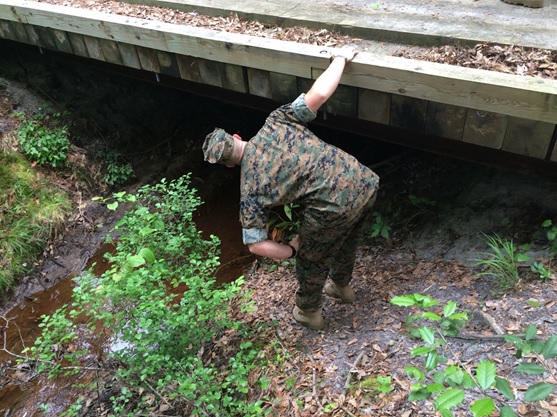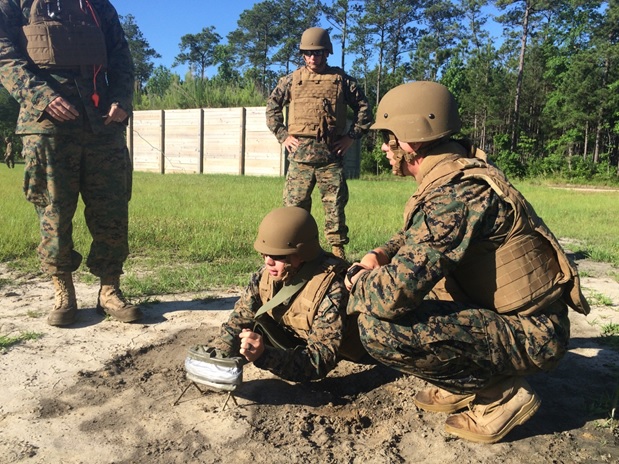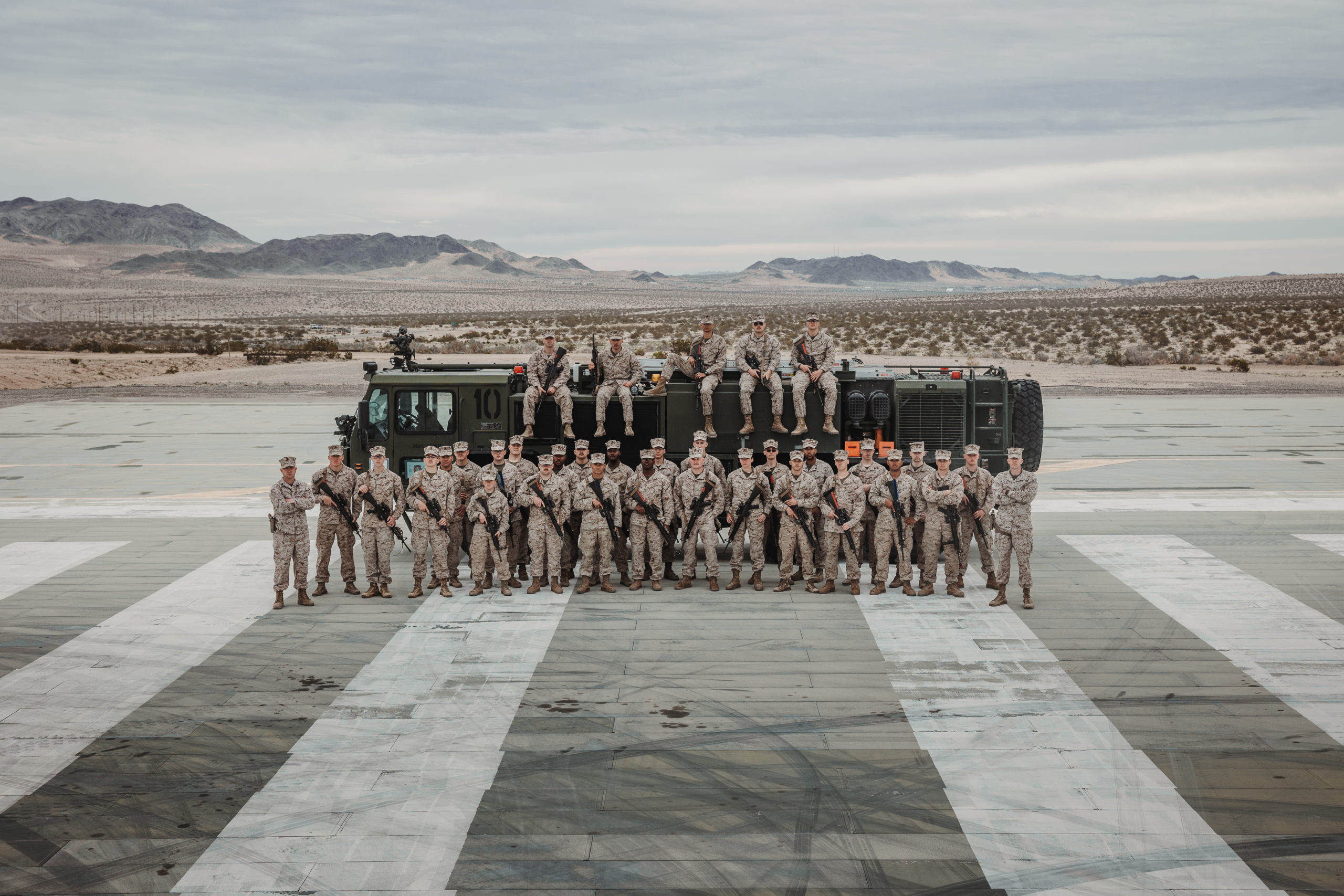By Robbin Laird
As the Marines rework how they approach distributed operations, a key focus is upon how to shape what they call Expeditionary Advanced Operations or EABO. This requires reworking how the air and ground elements operate together to shape a more effective distributed force with reduced force signature and an ability to operate at the point of interest more rapidly and effectively.
The Aviation Ground Support or AGS element of the air wing is of enhanced importance in such operations, but also faces significant challenges in being able to shape the infrastructure for such operations as well.
When I have visited MAWTS-1 over the past few years as the EABO concept has been worked, the AGS personnel I have talked with believed that their role is enhanced and calls for its inclusion as the 7th function of Marine Corps Aviation.
As we wrote in our recent book on MAWTS-1 about a visit to MAWTS-1 in September 2020:
A key element for an evolving combat architecture clearly is an ability to shape rapidly insertable infrastructure to support Marine air as it provides cover and support to the Marine Corps ground combat element. This clearly can be seen in the reworking of the approach of the Aviation Ground Support (AGS) within MAWTS-1 to training for the execution of the Forward Air Refueling Point mission.
During a visit to MAWTS-1 in early September 2020, I had a chance to continue an earlier discussion with Maj. Steve Bancroft, Aviation Ground Support (AGS) Department Head, MAWTS-1, MCAS Yuma. In this discussion it was very clear that the rethinking of how to do FARPs was part of a much broader shift in in combat architecture designed to enable the USMC to contribute more effectively to blue water expeditionary operations.
The focus is not just on establishing FARPs, but to do them more rapidly, and to move them around the chess board of a blue water expeditionary space more rapidly. FARPs become not simply mobile assets, but chess pieces on a dynamic air-sea-ground expeditionary battlespace in the maritime environment.
Given this shift, Maj. Bancroft made the case that the AGS capability should become the seventh key function of USMC Aviation. Currently, the six key functions of USMC Aviation are: offensive air support, anti-air warfare, assault support, air reconnaissance, electronic warfare, and control of aircraft and missiles. Bancroft argued that the Marine Corps capability to provide for expeditionary basing was a core competence which the Marines brought to the joint force and that its value was going up as the other services recognized the importance of basing flexibility, But even though a key contribution, AGS was still too much of a pick-up effort. AGS consists of 78 MOSs or Military Operational Specialties which means that when these Marines come to MAWTS-1 for a WTI, that they come together to work how to deliver the FARP capability.
As Maj. Bancroft highlighted: “The Marine Wing Support Squadron is the broadest unit in the Marine Corps. When the students come to WTI, they will know a portion of aviation ground support, so the vast majority are coming and learning brand new skill sets, which they did not know that the Marine Corps has. They come to learn new functions and new skill sets.”
His point was rather clear: “if the Marines are going to emphasize mobile and expeditionary basing, and to do so in new ways, it would be important to change this approach.”
Major Bancroft added: “I think aviation ground support, specifically FARP-ing, is one of the most unique functions the Marine Corps can provide to the broader military.
Clearly, senior USMC leadership recognizes the evolving role of AGS in an ability to do EABO.
For example, in the May 2023 Tentative Manual for Expeditionary Advanced Base Operations, 2nd Edition, it is noted about AGS:
Marine aviation has unique logistical and engineer support requirements that enable sortie generation. Support for expeditionary aviation necessitates consideration of these capabilities outside the conventional GCE/LCE support system. AGS enables ACE employment in an expeditionary manner. The MWSS is responsible for providing AGS and does this through execution of the six activities of AGS: forward aviation combat engineering operations, airfield operations, base recovery after attack (BRAAT) operations, airfield damage repair (ADR) operations, FARP missions, and aircraft salvage and recovery (ACSR) operations.
To counter peer and near-peer competitors the Fleet Marine Force must persist and win within the WEZ while operating from dispersed and disaggregated locations. The MWSS must be able to rapidly deploy capabilities from the sea and air to subsequently employ, integrate, and displace while simultaneously generating aviation sorties as part of an integrated naval force. EABO success requires integration and employment of AGS capabilities to support Marine, Naval, Combined, and Joint aviation forces across the competition continuum.
AGS focuses on establishing, maintaining, and repairing expeditionary airfields, landing strips, landing zones, and FARPs. Support can be tailored towards fixed wing, rotary wing, tilt-rotor, and unmanned aircraft. Specialized aviation planning and design is required to accomplish these tasks and is provided by subject matter experts resident within the expeditionary airfield company of the MWSS.
Once an airfield is established, the primary tasks of AGS is providing airfield services to include expeditionary airfield (EAF) services, expeditionary firefighting and rescue (EFR), aviation fuels distribution, and explosive ordnance disposal.
The MWSS provides the technical expertise, equipment, and personnel necessary to operate the flight line (e.g., emergency response, aircraft arrestment, aviation refueling, EOD response, managing flight line hours, lighting and marking, and establishing parking).
Another dedicated mission conducted by the MWSS is BRAAT. This is the assessment and restoration of essential airfield operations following an enemy attack involving damage or destruction to the airfield. Aviation units must be restored to the minimum level of combat effectiveness.
The objective of BRAAT is to determine the minimum operating strip, which is the minimum amount of area required to launch and recover aircraft. ADR is conducted concurrently with BRAAT, once areas are cleared to begin repair operations. It is initiated to restore an airfield to the minimum operating capability by using materials, procedures, and techniques for rapid repair of damaged operating surfaces to provide for tactical aircraft launch and recovery operations.
ADR involves extensive engineer, airfield operations, and coordinated support efforts. Specialized ADR planning is required to ensure the proper personnel, equipment, and materials are available to rapidly restore the airfield to a state of sortie generation. The MWSS is responsible for calculating estimates for repair time, material requirements, and executing the mission.
Specific missions performed by the MWSS include FARP and ACSR. A FARP provides fuel and ordnance necessary for highly mobile and versatile helicopter, tiltrotor, and fixed wing operations. The size of the FARP varies with the mission and the number of aircraft to be serviced. The ultimate objective of a FARP is to minimize response time and decrease turn-around time in support of sustained operations. This is achieved by minimizing flight time to-and-from the refueling and rearming point and reducing the refueling and rearming time.
The MWSS is often augmented with personnel from the Marine aviation logistics squadrons for aviation ordnance operations, and Marine aircraft control group personnel to provide air traffic control and communications. Salvaging or recovering an aircraft involves the action of removing an aircraft from a mishap site to facilitate clearance of landing zones, recovery of assets, and repairs to the aircraft.
Execution is for the specific purpose of the safe salvage and/or recovery of aircraft without unnecessary damage to the aircraft. The composition of an ACSR mission may vary and each mission requires a planning process where the quantity, minimum operating strip, and billet of each member taking part in the mission shall be determined to meet mission requirements to support the mission.
Recently, I visited 2nd Marine Wing and visited MWSS-272 to discuss how they were doing in shaping such a significant transition.
In a photo released in 2023, the activities of the wing were recognized and their role identified as follows:

U.S. Marines with Marine Wing Support Squadron (MWSS) 272 pose for a photo at Marine Corps Air Station New River, North Carolina, May 25, 2023. MWSS-272 earned the 2023 James E. Hatch Award for Marine Wing Support Squadron of the Year, given to the most outstanding wing support squadron that enhanced support to aviation by furnishing transportation, engineering, and communication essentials. MWSS‐272 is a subordinate unit of 2nd Marine Aircraft Wing, the aviation combat element of II Marine Expeditionary Force.
These combat engineers face a significant challenge in terms of working a different kind of mobile operations and will need in my view need to need some new equipment and investments in order to do so.
During my July 2024 visit to New River, I had a chance to talk with Maj. Thomas Cofer, the operations officer at the squadron. Cofer has served in Iraq with the Marines and the Army in Afghanistan and is an experienced combat engineer. And he is working in the squadron to help shape its way ahead.
Throughout the discussion with Maj. Cofer underscored the clear need to reshape their support capabilities to enable to enabled distributed operations. This is how he put it: “You have to have support that can be tailor made to deploy and project power forward.”
This means that you have revamp the force to have support equipment which can be moved more rapidly than legacy gear. The Marine Corps has introduced new equipment and technology to the MWSS that facilitates their ability to accomplish their mission quicker and more efficiently to include advanced technology for BRAAT and ADR mission. However, replacing earth moving equipment is difficult due to the nature of its mission. This is clearly a work in progress.
As he put it: “Some of our support equipment are too heavy to be transported, right?
“We have recently done an exercise in the Bahamas for Distributed Aviation Operations Exercise, and we had to scale some of our planning back because of the limited ship-to-shore connectors available, and the weight of some of the support equipment.
“We need to be able to provide support with a lighter and more mobile package. I think that’s going to be the key to success moving forward.”




